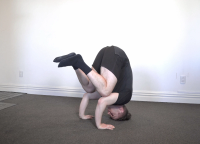
0/5
Lvl 1
3 sec
Lvl 2
5 sec
Lvl 3
8 sec
Boss
10 sec
Master
30 sec
Balancing out in open space can be scary, but the concepts are all the same as when you were against a wall. Remember, if you lose your balance backwards, crunch yourself into a tight ball and perform a forward roll. Place your hands roughly shoulder width apart on the floor. Imagine your hands are the base of a triangle, place the top of your head where the top of the triangle would be. Placing your head on something thin and soft is recommended for comfort. Grip the floor tight with your fingers and hands while pushing through your shoulders and arms to create a stable base. Squeeze your hips, folding them up high towards the ceiling. Place your knees on the backs of your arms. Keep your elbows in a tight 90-degree angle, with your elbows over your wrists. Repeat for your target time and sets.
Repeat this movement 2-3 times per week. Perform 3 sets of your target time. Each week aim to add 1 or more seconds to your hold until you have completed the "Boss" level. Once you have completed the "Boss" level, we recommend you move on to the next exercise. Come back at any time and attempt to master this exercise.
Headstands can be a physically demanding and potentially risky exercise pose that requires careful consideration and preparation. Before attempting a headstand, it is essential to be aware of the following cautionary points: Performing headstands can pose significant risks to your safety and well-being. If executed improperly or without proper guidance, headstands can lead to serious neck, spine, or head injuries. Individuals with pre-existing medical conditions such as hypertension, glaucoma, or osteoporosis should exercise extreme caution or avoid headstands altogether, as they may exacerbate these conditions. Always seek professional instruction and ensure you have developed the necessary strength and balance before attempting headstands. Prioritize safety and consult with a healthcare professional if you have any doubts or concerns about your ability to perform this inversion pose safely.
| Date | Result | Notes |
|---|